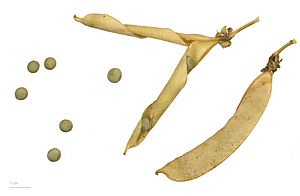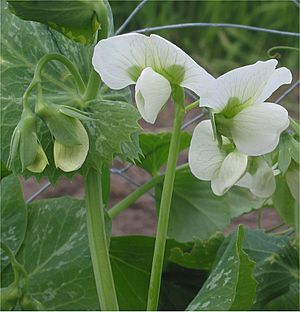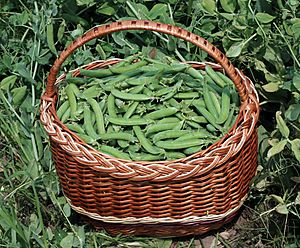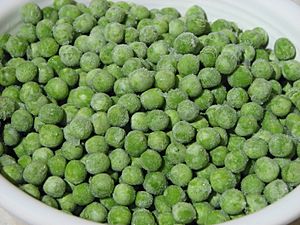Pea facts for kids
Quick facts for kids Pea |
|
|---|---|
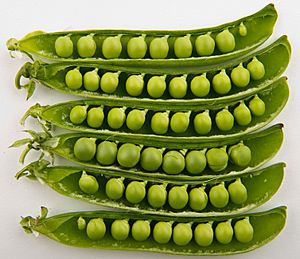 |
|
| Peas are contained within a pod. | |
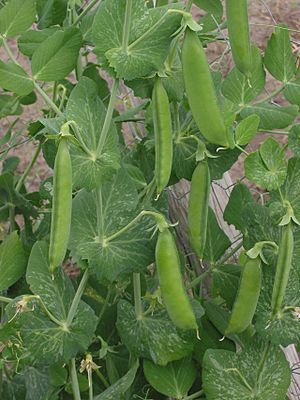 |
|
| Pea plant: Pisum sativum | |
| Scientific classification | |
| Synonyms | |
|
A pea is a small, round seed found inside a pod. These pods are actually a type of fruit, because they hold seeds and grow from a pea flower. Peas can be green or yellow.
The pea plant is an annual plant, meaning it completes its whole life cycle in just one year. Peas grow best in cool weather. They are planted from winter to early summer, depending on where you live.
An average pea weighs between 0.1 and 0.36 grams. Young, fresh peas are eaten as a vegetable. You can find them fresh, frozen, or canned. Some types, like snow peas, have tender pods that you can eat too. Other types, called field peas, are grown to make dry peas, like split peas. These dry peas are used to make dishes like pease porridge and pea soup. Eating fresh, young green peas became popular in Europe during the Early Modern period.
Wild peas originally grew only in the Mediterranean region and the Near East.
Contents
What are Peas Like?
Peas are usually green, but can also be golden yellow or sometimes purple. They grow inside a pod. Peas are a popular cool-season vegetable crop. You can plant pea seeds when the soil temperature reaches about 10°C (50°F). Pea plants grow best in temperatures between 13°C and 18°C (55°F and 65°F). They don't do well in hot summer weather. Many pea types are ready to harvest about 60 days after planting.
Pea plants can grow in two ways: some stay low to the ground, while others are vining plants. Vining peas grow thin tendrils from their leaves. These tendrils wrap around anything nearby, helping the plant climb up to 1–2 meters (3–6 feet) high. Farmers often use branches, fences, or netting to support climbing peas. When many pea plants grow close together, they can support each other. Pea plants can also self-pollinate, meaning they can fertilize themselves.
A Brief History of Peas
Long ago, peas were mostly grown for their dry seeds. People living in the Mediterranean region started choosing and growing the best wild pea plants. This helped improve how much food the plants produced. This started around the Neolithic period, when farming began.
Around 300 BC, a Greek writer named Theophrastus mentioned peas as a legume that was planted late in winter because they were delicate. In the first century AD, a Roman writer named Columella wrote about peas. Roman soldiers would even gather wild peas from sandy areas to add to their food.
During the Middle Ages, field peas were very important. They helped prevent famine (when there isn't enough food).
Fresh "garden" peas, which are eaten young, became a special treat in Early Modern Europe. In England, people started telling the difference between "field peas" (for drying) and "garden peas" (for eating fresh) in the early 1600s.
Sugar peas, which the French called mange-tout (meaning "eat all" because you eat the pod too), came to France from Holland in the late 1500s. Fresh green peas were brought from Genoa to the court of Louis XIV of France in 1660.
Modern split peas, which have their tough outer skins removed, were developed later in the 1800s.
How Peas are Used Today
Today, peas are usually boiled or steamed. Cooking them this way makes them taste sweeter and helps your body absorb their nutrients better. In the Middle Ages, peas were a very important food for many people in the Middle East, North Africa, and Europe.
By the 1600s and 1700s, it became popular to eat peas "green," meaning when they were young and fresh. New types of peas, called "garden" or "English" peas, were developed in England. The idea of eating green peas spread to North America. Thomas Jefferson grew over 30 different kinds of peas on his farm! When canning and freezing foods were invented, green peas became available all year round, not just in spring.
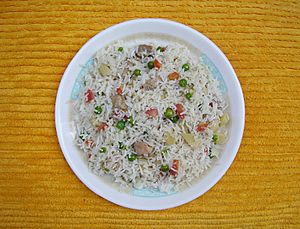
Fresh peas are often served as a side dish, boiled and flavored with butter or spearmint. Salt and pepper are also commonly added. Fresh peas are also used in pot pies, salads, and casseroles. Pod peas (like sweet mange tout or flat "snow peas") are used in stir-fried dishes, especially in American Chinese cuisine. Pea pods don't stay fresh for long after being picked. If you don't use them quickly, it's best to dry, can, or freeze them within a few hours.
In India, fresh peas are used in many dishes, like aloo matar (curried potatoes with peas) or matar paneer (cheese with peas). Frozen peas can be used instead. Peas are also eaten raw, as they are sweet when fresh from the plant. Split peas are used to make dal, especially in Guyana and Trinidad.
Dried peas are often made into soup or eaten on their own. In Japan, China, Taiwan, and some Southeast Asian countries, peas are roasted and salted to make snacks. In the Philippines, peas in their pods are a common ingredient in main dishes and pansit noodles. In the UK, dried yellow or green split peas are used to make pease pudding, a traditional dish. In North America, a similar traditional dish is split pea soup.
Pea soup is eaten in many parts of the world, including northern Europe, middle Europe, Russia, Iran, Iraq, and India. In Sweden, it's called ärtsoppa. It's a very old traditional Swedish food that was popular among poorer people.
In Chinese cuisine, the tender new leaves and stems of the pea plant, called dou miao, are often used in stir-fries. Farmers pick the tips of the pea plant, similar to how leaves are picked for tea.
In Greece, Tunisia, Turkey, Cyprus, and other Mediterranean countries, peas are made into a stew with lamb and potatoes.
In Hungary and Serbia, pea soup is often served with dumplings and spiced with hot paprika.
In the United Kingdom, dried, rehydrated, and mashed marrowfat peas, known as mushy peas, are very popular. They are often eaten with fish and chips or meat pies. Sometimes, baking soda is added to make the peas softer. In 2005, a survey found that peas were Britain's seventh favorite vegetable!
Processed peas are mature peas that have been dried, soaked, and then heat-treated to prevent them from spoiling. Cooked peas are sometimes sold dried and coated with wasabi, salt, or other spices.
In North America, pea milk is made and sold as an alternative to cow's milk.
How Frozen Peas are Made
To freeze and preserve peas, they first need to be grown, picked, and shelled. Usually, the most tender peas are chosen for freezing. Peas must be frozen soon after they are picked so they don't spoil.
Once the peas are chosen, they are put into ice water to cool down. After that, they are sprayed with water to wash off any dirt or dust.
The next step is blanching. The peas are boiled for a few minutes. This removes enzymes that could make them spoil faster. Then, they are cooled and taken out of the water.
The final step is the actual freezing process. This can be done in different ways. Some companies use air blast freezing, where peas go through a tunnel at high speeds and are frozen by very cold air.
Finally, the peas are packaged and sent to stores.
Sorting Peas by Size
Pea grading means sorting peas by their size. The smallest peas are considered the best quality because they are the most tender. Sometimes, peas are floated in salty water (brine) to figure out their density, which also helps with sorting.
What Nutrients Do Peas Have?
Peas are starchy, but they are also high in fiber and protein. They contain many important vitamins and minerals, including vitamin A, vitamin B6, vitamin C, vitamin K, phosphorus, magnesium, copper, iron, zinc, and lutein. When dried, about a quarter of a pea's weight is protein and another quarter is sugar.
Different Kinds of Peas
There are many different types of garden peas. Some common ones are listed here. "PMR" means they have some resistance to powdery mildew. "Afila" types, also called semi-leafless, have clusters of tendrils instead of leaves. Most of these are "dwarf" varieties, which grow to about 1 meter (3 feet) tall. It's good to give vining peas support, but it's not always necessary.
Field Peas
The field pea is a type of pea sometimes called P. sativum subsp. arvense. It's also known as dun (grey-brown) pea, Kapucijner pea, or Austrian winter pea. It's one of the oldest crops grown by humans, cultivated for at least 7,000 years! Field peas are now grown in many countries for both human food and animal feed. There are different types and colors, including blue, dun (brown), maple, and white. This pea is different from the cowpea (Vigna unguiculata), which is sometimes called "field pea" in warmer places.
Field peas are climbing annual legumes with weak, vine-like stems. The vines can grow 120 to 150 cm (4 to 5 feet) long. However, if grown without support, they usually only reach 45 to 60 cm (1.5 to 2 feet) tall. Their leaves have two small leaflets and a tendril. The flowers can be white, pink, or purple. The pods contain large, nearly round seeds that can be white, gray, green, or brown. The roots are not very deep but have good nodules (small bumps where helpful bacteria live).
The field pea is a cool-season legume crop grown on over 25 million acres worldwide. It has been an important grain legume crop for thousands of years. Seeds showing signs of being grown by humans have been found in ancient sites in what is now Turkey, dating back at least 7,000 years. Field peas, or "dry peas," are sold as a dry, shelled product for human or livestock food. This is different from garden peas, which are sold fresh or canned. The main countries that grow field peas are Russia and China, followed by Canada, Europe, Australia, and the United States. These countries are major exporters of peas.
Peas in Science
In the mid-1800s, an Austrian monk named Gregor Mendel studied pea plants. His observations led to the ideas of Mendelian genetics, which is the basis of modern genetics. He grew and examined about 28,000 pea plants for his experiments! Mendel chose peas because they were easy to grow. He could also create pure types, prevent unwanted cross-pollination, and control how they pollinated.
Mendel cross-bred tall and dwarf pea plants, green and yellow peas, purple and white flowers, wrinkled and smooth peas, and a few other traits. He then watched what happened to their offspring. In each case, one trait was "dominant." All the first generation of offspring (called F1) showed this dominant trait. Then, he crossed members of the F1 generation with each other. He observed their offspring, the second generation (called F2). The F2 plants showed the dominant trait in about a 3:1 ratio.
Mendel realized that each parent passed on a "factor" for a trait. The non-dominant, or recessive, trait only appeared if the offspring inherited it from both parents. He did more experiments that showed each trait was inherited separately.
Without knowing it, Mendel solved a big problem with Charles Darwin's theory of evolution. Darwin wondered how new traits were kept and not just blended away in a population. Mendel's work was published in a small Austrian journal and wasn't widely known until around 1900.
Images for kids
See also
 In Spanish: Guisante para niños
In Spanish: Guisante para niños


